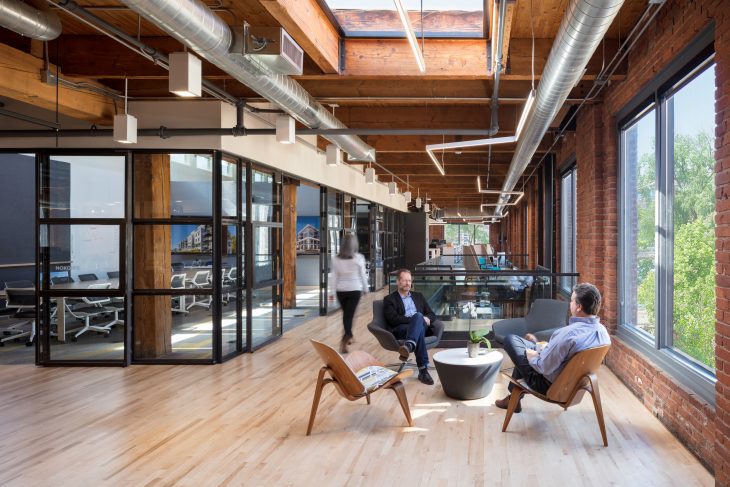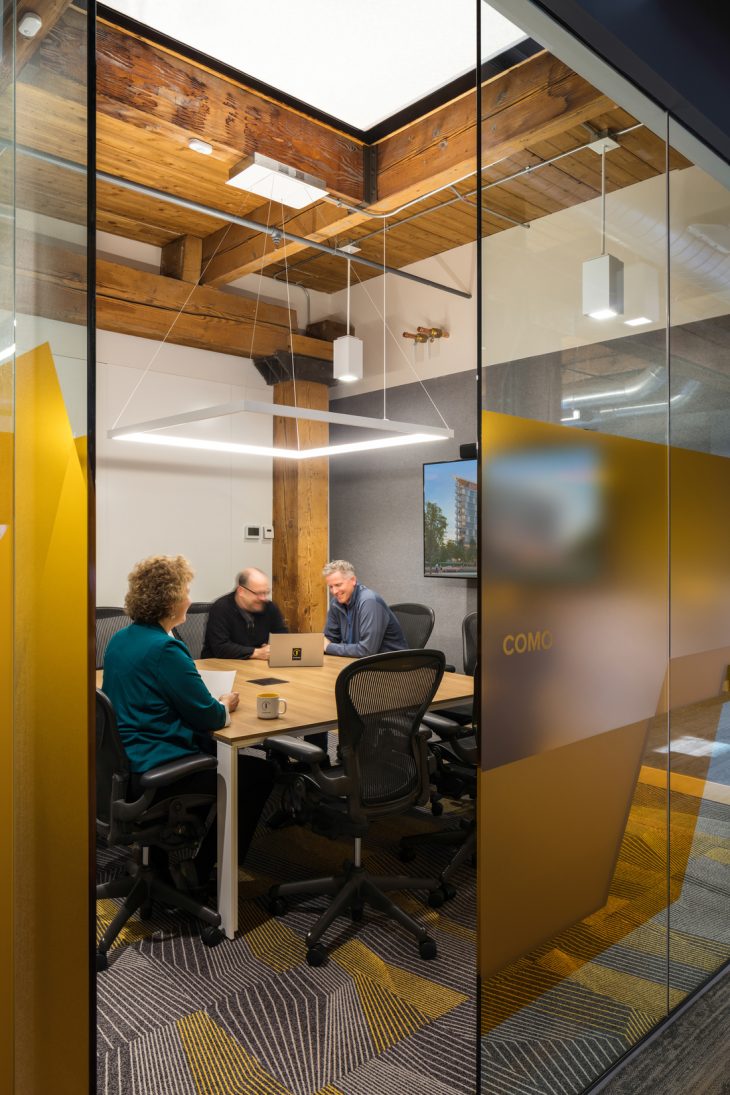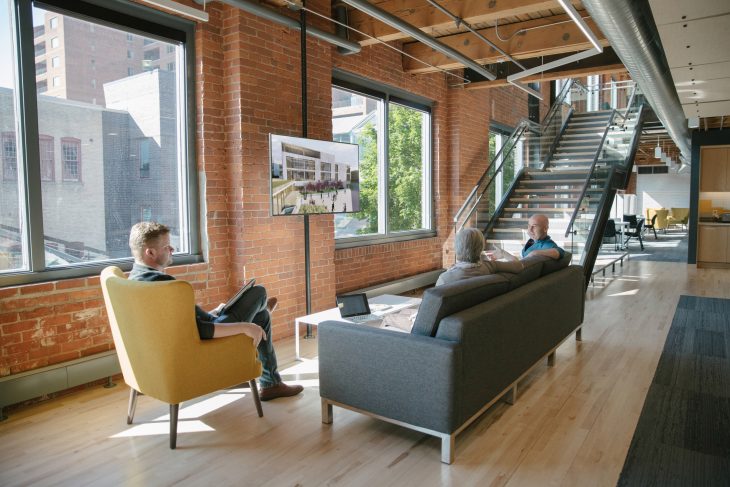The newly renovated offices for Cuningham Group Architecture accommodates growth and expansion, all while adhering to WELL Building Living Standards – a first for a company based in Minneapolis.
The renovation of Cuningham Group Architecture’s Minneapolis headquarters in the historic St. Anthony Main office complex along the Mississippi River was marked during the firms 50th anniversary and part of a unifying branding effort across all Cuningham Group offices. The renovation to the top two floors of the four-story office came out of the firm’s need to address plans for future growth and expansion. It also responded to density and space equity issues by addressing the changing work styles of the nearly 200 Cuningham Group employees located in Minneapolis.
To celebrate its 50th anniversary and renovated milestone, the firm’s employees helped assemble brand new dressers at Bridging and packed food at the Sheridan Story. 
When was the project completed?
2018
How much space?
18,100 SF
Was this new or renovated space?
Renovated

SF per person?
103 SF per person
How many employees?
176
What is the average daily population?
176

Describe workspace types.
Previously, the workspace was set up with walls separating the workstations from a shared, center space. To open up the experience to the river, the design team moved the “spine” of the space from the center to the edge along the expanse of existing windows, maximizing daylight and views. Included, is an open feature stair that is wide enough for quick conversations. All workstations are the same size and feature stand-up desks. In addition, the new office features multiple shared work and gathering places, including high-use open kitchen spaces on each floor.
What kind of meeting spaces are provided?
Open table space and flexible seating arrangements along the windows allow for team meetings, gathering spots, and quiet workspaces for individuals. In addition, conference rooms feature clerestory windows and skylights.
What other kinds of support space or amenity spaces are provided?
The new office features several multi-functional, shared work and gathering places, including high-use open kitchen spaces, informal sitting areas, and flexible furniture. In addition, a Collaboration Lab and Materials Library is situated in a central location on the second floor. Teams can easily pull materials and review them in various lighting, as well as experiment with new technologies and collaborate with large and small teams.

Has the project achieved any special certifications (i.e. LEED, WELL, Living Building Challenge)?
Cuningham Group followed the WELL Building Standard™ (WELL), which closely aligns with the firm’s long-standing core values. WELL is the first building standard to focus exclusively on the health and wellness of the people in buildings. WELL design features include ergonomic workstations, acoustic comfort, thermal comfort, integrative design (team coordination), altruism (charitable activities), and adaptable spaces (flexible design and multifunction areas).
What are the project’s location and proximity to public transportation and/or other amenities?
The project is located next to a bus route, walking and biking trails, a connected parking garage, and near a variety of dining and entertainment options.
Was the “C” Suite involved in the project planning and design process? If so, how?
CEO Tim Dufault attended design meetings

What kind of programming or visioning activities were used?
The renovation process was unique in that Cuningham Group employees served as both the project’s designer and client. As a result, two separate teams, a “design team” and a “client team” were developed. The design team worked to implement the client team’s input and needs, just like any other Cuningham Group project. The client team served to represent the nearly 200 employees, communicating input and needs, but also regular updates on the design process.
Were any pre-planning surveys conducted to get employee input?
We worked with the University of Minnesota’s Center for Sustainable Building Research to conduct both pre-occupancy and (pending) post-occupancy surveys to measure the qualities of our working environment. We also conducted independent surveys during the design process to gather feedback about the project.
Was there any other kind of employee engagement activities?
During the design process, the project was presented several times at All-Office Meetings and other staff events. Tours of the project during construction were also conducted.

Were any change management initiatives employed?
In addition to regular communication about the renovation design, we also installed a sample workstation in our temporary office, so that employees could test out the features and get used to the new configuration.
Please describe any program requirements that were unique or required any special research or design requirements.
Being located in the historic St. Anthony Main office complex, the renovation had to blend 21st Century office design, sustainability, and state-of-the-art technology in a late-1800’s building.
Was there any emphasis or requirements on programming for health and wellbeing initiatives for employees?
Employee wellbeing was one of the project’s central design initiatives. As such, the renovation incorporates a number of features that balance building performance with employee comfort. These features include strong attention to daylighting, equitable workstations and meeting spaces, and quiet workspace and gathering spots. Employees have the ability to control the amount of light with window coverings and a daylight sensor array.
Cuningham Group also followed the WELL Building Standard™ (WELL). WELL design features include ergonomic workstations, acoustic comfort, thermal comfort, integrative design (team coordination), altruism (charitable activities), and adaptable spaces (flexible design and multifunction areas).

Were there any special or unusual construction materials or techniques employed in the project?
A simple palette of wood felt and patterned carpet complement and soften the existing building materials without overwhelming them. Furnishings were carefully selected to support many work styles desired throughout the workday. Many of the design selections are meant to be experimentation on ourselves, including lighting, technology, and furniture, which then allow us to bring specific experience and lessons learned to our clients.
What kind of branding elements were incorporated into the design?
Brand colors and storytelling elements are strong throughout the finish materials and furnishings. The entryway, for example, leads to a large, industrial steel door with “Cuningham yellow”- tinted glass panels and graphics that feature the firm’s name and design specialties.
What is the most unique feature of the new space?
The most unique feature of the new space is the reimagined layout. Previously, the office was set up with walls separating the workstations from a shared, center space. The redesign flipped this setup “inside out.” Now, shared spaces exist on the edges, alongside the expanse of windows. Workstations are no longer individually partitioned off from one another. This maximizes daylight and opens up the experience to the river.

Are there any furnishings or spaces specifically included to promote wellness/wellbeing?
All workstations are sit-to-stand and modular. Employees have the ability to control the amount of light with window coverings and a daylight sensor array.
What kind of technology products were used?
Seven of the meeting spaces are video conference capable and are equipped with an energy monitoring and control system that displays usage statistics in real-time.

Tell us more!
Architect: Cuningham Group Architecture
MEP Engineer: Emanuelson-Podas
Contractor: Mortenson Construction
Images courtesy of Cooperthwaite Photography



Hi,
Thankyou this is the best sharing information about in Industrial Commercial Refurbishment’s
This Is Really Great Work. Thank You For Sharing Such A Good And Useful Information Here In The Blog